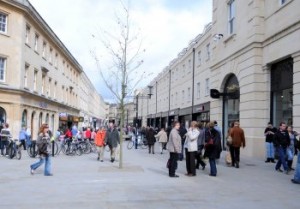Consumers in the South West are continuing to shrug off the tough economic conditions by spending more in the shops and online, new data out today shows.
Spending by families and individuals in the region grew by 2.8% last month – the sixth month in a row that it has been above inflation.
Restaurants in particular enjoyed a strong September with an 11.2% annual increase. Spending on DIY (5.8%) and clothing (2.4%) also rose as consumers started to loosen their purse strings, according to the research by Barclaycard.
Today’s figures emerge after a series of recent surveys showing average wages rises continuing to trail the rate of inflation. However, house prices are now rising across the region.
While average transaction values continued to fall the number of transactions grew as canny consumers sought value for money by hunting down the best bargains from different shops and websites.
Barclaycard’s monthly analysis of UK spending shows that the restaurant sector enjoyed a good September with the strongest growth recorded this year – and much higher than the growth of a year ago (September 2012: 5.3%) – as families made the most of the mild start to autumn to eat out.
However, the average spend was 6.3% lower, suggesting that they while they ate out more they spent less each time.
Online spending on clothing rose sharply as consumers updated their wardrobes for autumn and sought out the latest fashions online in advance of them hitting the high street. Men’s and Women’s clothing were up 38% and 36.1% respectively.
DIY spending increased by 5.8% on the back of the rebounding housing market but garden centre spending dropped by 2.2% following a strong performance earlier in the summer.
The shift from driving to public transport continued. Spending on petrol dipped by 2.1% after three months of growth over the summer, while spending on public transport grew 4.8% on the same month last year.
Tighter family finances are having an impact on the supermarket shopping, according to the research. Consumers remain determined to get the best value and so a new trend of ‘little and often’ is emerging which could put an end to the traditional weekly shop.
The average transaction value for supermarket spending in September fell 5.2%, while the number of transactions was up 4.8% year-on-year – suggesting that instead of doing their supermarket shopping all in one go, consumers are hunting down the best bargains by visiting a number of different shops.
Overall supermarket spending for the month fell slightly (-0.7%), despite higher food inflation (4.1% in August) pushing prices up.



















